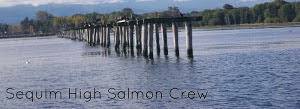Thursday, December 12, 2013
Viewing Salmon at the Rail Road Bridge Park
The Sequim High Salmon Coalition walked along different side streams, and main streams in search of salmon, big and small. Along the acute streams we discovered salmon fry schools. The fry were cautiously crowding beneath the shadowed estuaries, safe from predators. We continued on the trails to the main stream looking out for bigger salmon, but none were found. Our mentor Reed, showed us how to identify various different types of plants including: Himalayan/Native Blackberry, Western Red Cedar, Alder, Oregon Grape, and Big Leaf Maple. On the way back to our ride home we looked at an invasive species called Herb Robert, which are usually found on trails, stuck onto different animals and people going through.
Thursday, December 5, 2013
Sequim High Students Clean Up Three Crabs
Four students from Sequim High School and Larry Montague from NOSC took part in a clean-up effort to clear the debris left over from the Three Crabs Restaurant demolition. The main goal of our team was to pick up debris that could blow into Meadowbrook Creek and Dungeness Bay. Hazardous materials we picked up included insulation, foam, plastic, particle board, and other light materials. The point was to benefit not only salmon, but people and birds as well. We don't want birds to eat Styrofoam during the winter! There were five of us working hard in the cold, snowy weather. It was tedious work picking up the smallest bits of material! In the end, there were 5 trash bags filled. We left feeling proud and accomplished to know we were helping keep the wildlife safe by keeping the pollutants out of the water
Sequim High Students Clean Up Debris from Demolition
Saturday, November 30, 2013
An Educational Trip to Meadowbrook creek
Sequim High School students and employees of the North Olympic Salmon Coalition took a trip to Morse Creek this previous October! The students are taking a Natural Resources class, basing their class projects off of volunteering with NOSC. We drove the "Moby Dick," a suburban used by NOSC, to the partially muddy creek. Reed Aubin, the group coordinator and teacher, took the students on a trail to examine engineered log jams, salmon, and the general ecosystem of Morse Creek. Essentially, they received their first glance of what the class would be like. The students saw big tree logs layered into the ground, on the sides of the creek, in a particular formation. These are the engineered log jams (ELJ), and they direct a flow of water, preventing overflow or path displacement of the creek. ELJs also re-establish habitat essential to young salmon to feed, rest and escape predators. They also help the river retain smaller sized gravel in a correct assortment for the survival of salmon eggs. Another thing the class observed at Morse Creek was large woody debris (LWD), and small woody debris (SWD). LWD and SWD are essential in water ecosystems, for their decomposition results in the distribution of nutrients and chemicals that are beneficial for the plant and animal organisms that take habitat there. At the end of the day, the class left with a better understanding of one of many successful projects done by NOSC, and a look at the future of their class.
Want to see what an ELJ looks like? Check out the link below!
Engineered Log Jam
This is Morse Creek!
https://maps.google.com/maps?q=Morse+Creek,+Port+Angeles+East,+WA&hl=en&ll=48.112188,-123.34445&spn=0.019026,0.052314&sll=48.073491,-123.105927&sspn=0.609288,1.674042&oq=Morse+creek,+port+&t=h&hnear=Morse+Creek&z=15
Saturday, November 2, 2013
Pictures of 3 Crabs Prior to Restoration
 |
Meadowbrook Creek is the stream you see by the road that leads to the line of houses.
|
Subscribe to:
Posts (Atom)


.JPG)
.JPG)

